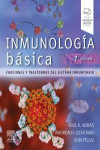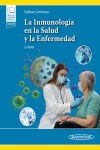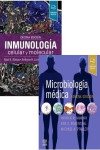FOOD ALLERGY. MOLECULAR AND CLINICAL PRACTICE
Lopata, A.
Producto agotado
Datos técnicos
- ISBN 9781498722445
- Año Edición 2017
- Páginas 350
- Idioma Inglés
Sinopsis
Food allergy is an adverse immunological reaction to allergens present in food. Up to 4% adults and 8% children are affected by food allergy. The increase in allergic diseases to food has led to the need for better diagnostics and more effective therapeuticapproaches.
This book describes the molecular biology and immunology of major food allergens, from laboratory based science to clinical immunology, encompassing novel characterisation and quantification methods, the application of recombinant food allergens in molecular diagnosis and the development of novel therapeutics. This book is the ideal reference tool for researchers, students and allergy clinicians to accurately diagnose and manage food allergies.
Features
Covers methods used to characterize allergenic proteins, including chemical, genetic, immunological approaches and animal models
Discusses the interaction of allergenic proteins with the immune system
Discusses immunological cross-reactivity among allergens and impact on clinical reactivity
Provides epidemiological data on food allergies
Reviews different clinical and molecular diagnostic approaches in determining allergic sensitization
Presents current literature in the field of molecular immunology and clinical allergology
Serves as a guide for laboratory and clinical based scientist in the field of food allergy
Contents
Biomolecular Aspects of Food Allergens
Prolamine Superfamily
Cupin Superfamily
EF-hand Superfamily
Tropomyosin-like Superfamily
Profilin-like Superfamily
Bet v 1-like Superfamily
The Casein and the Casein Kappa Family
Calycin-like Superfamily
Conclusions
Acknowledgements
References
Nomenclature of Food Allergens
Introduction
Allergen Nomenclature
Submitting new allergens to the WHO/IUIS allergen database
Conclusions
References
Nut Allergy
Introduction
Why are nut allergens so allergenic?
What therapies are currently addressing nut allergy?
Exploring causes of nut allergy
Conclusions
References
Egg Allergy
Introduction
Egg protein allergens: composition and chemistry
Primary prevention of egg allergy
IgE-mediated egg allergy
Non-IgE mediated food allergy
References
Fish Allergy
Introduction
Fish allergens
Translational aspects: from bench to bedside
Acknowledgement
References
Recent Advances in Diagnosis and Management of Shellfish Allergy
Introduction
Classifications of shellfish
Prevalence of shellfish allergy
Clinical manifestations and routes of exposure
Shellfish Allergens
Clinical and Immunological cross reactivity
Allergy diagnosis and management
Food processing and effect on allergens
Conclusions
Acknowledgement
References
Anisakis, Allergy and the Globalization of Food
Introduction
The parasite
Anisakiasis: A Commonly Overlooked Infection
Clinical implications of travelling and globalization of food products on health
Conclusions
References
Occupational Allergy and Asthma Associated with Inhalant Food Allergens
Introduction – Food industry and high risk working populations
Food processing activities and allergen sources
Epidemiology and risk factors
Clinical features and diagnostic approaches
Biological and Biochemical characteristics of known occupational Allergens
Preventive approaches
Conclusions
References
The Influence of Dietary Protein Modification During Food Processing on Food Allergy
Introduction
Food protein modification: From processing to digestion
Thermal food processing
Specific influence of food processing methods on allergenic food compounds
Chemical food modifications: Nitration of dietary proteins
Nitration as a concern in food allergy
Further chemical modifications: Reduction and oxidation of food proteins
Conclusions
Acknowledgement
References
Detection of Food Allergen Residues by Immunoassays and Mass Spectrometry
Introduction
Precautionary labelling of food allergens
Immunoassays
Development of an ELISA
ELISA optimization
Mass spectrometry for food allergen detection
Conclusions
References
Keywords
Recombinant Food Allergens for Diagnosis and Therapy
Introduction
Recombinant food allergens
Physicochemical analysis of recombinant food allergens
Immunological analyses of recombinant food allergens
Recombinant food allergens for diagnosis
Recombinant food allergens for allergy therapy
Conclusions
Acknowledgments
References
Peanut Allergy: Biomolecular Characterization for Development of a Peanut T Cell Epitope Peptide Therapy
Introduction
Clinical features of peanut allergy
The mucosal immune response to peanut allergens
Allergenic components of peanut
Biochemical properties of peanut allergens
Specific Immunotherapy for peanut allergy
Development of SPIRE therapy
Design of a SPIRE therapeutic for peanut allergy
Conclusions
Acknowledgments
References
Editor(s) Bio
Andreas Ludwig Lopata, Ph.D., is a professor in the Department of Pharmacy and Molecular Sciences at James Cook University, Townsville, Queensland, Australia.
Otros libros que te pueden interesar
- ¿Quiénes somos?
- Gastos de envío
- Política de privacidad
- Políticas de devolución y anulación
- Condiciones Generales de contratación
- Contacto
2024 © Vuestros Libros Siglo XXI | Desarrollo Web Factor Ideas









